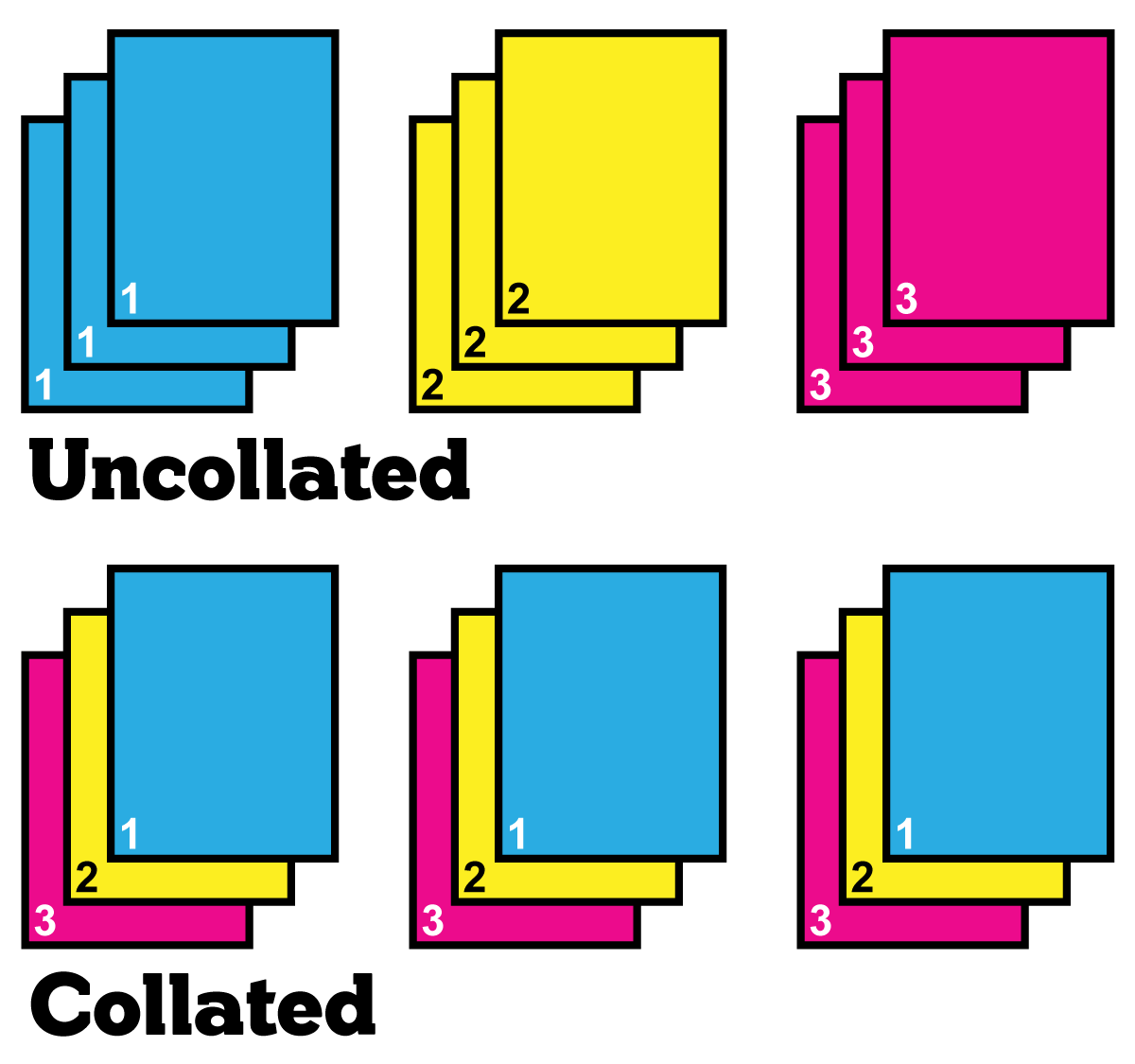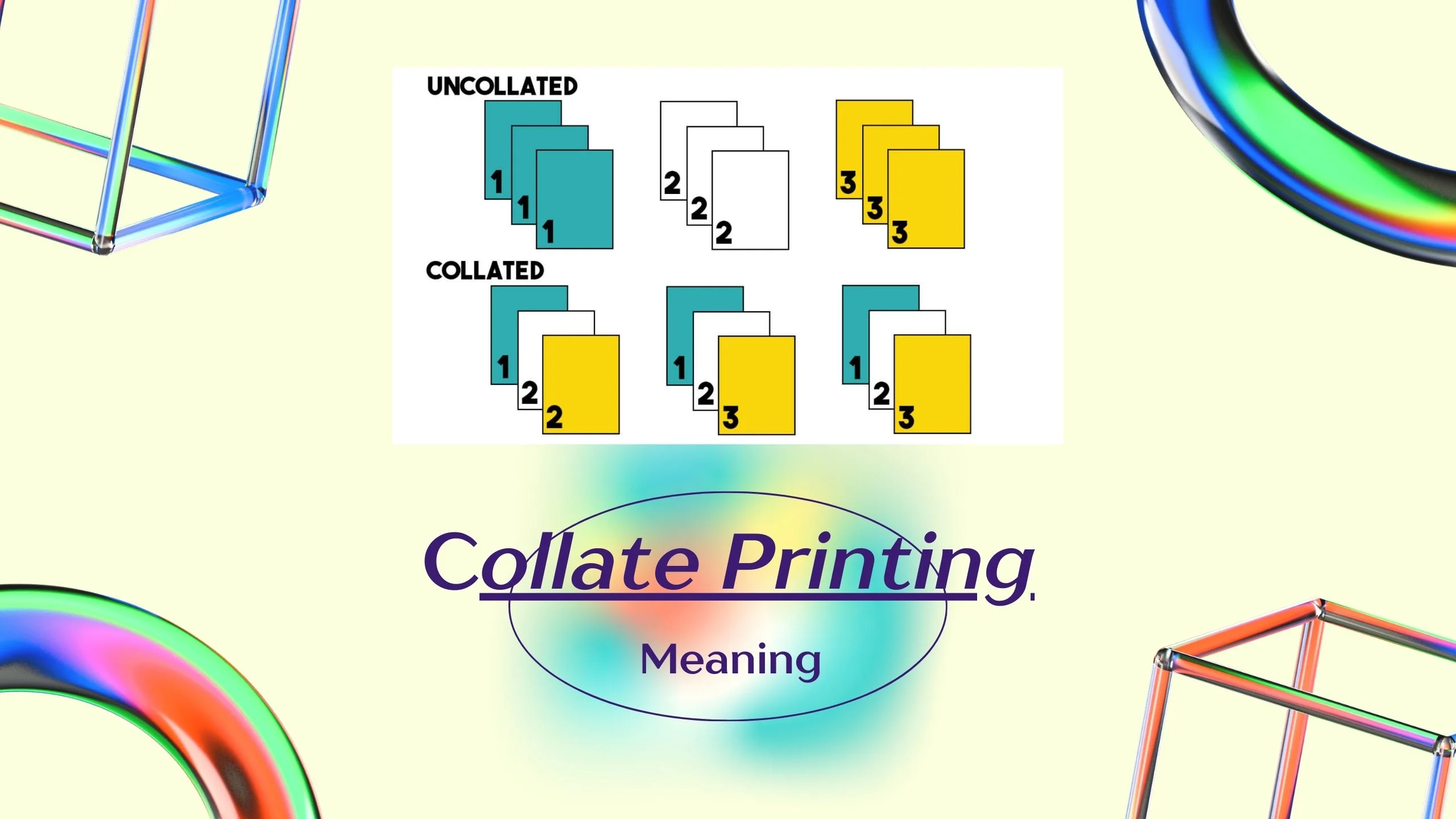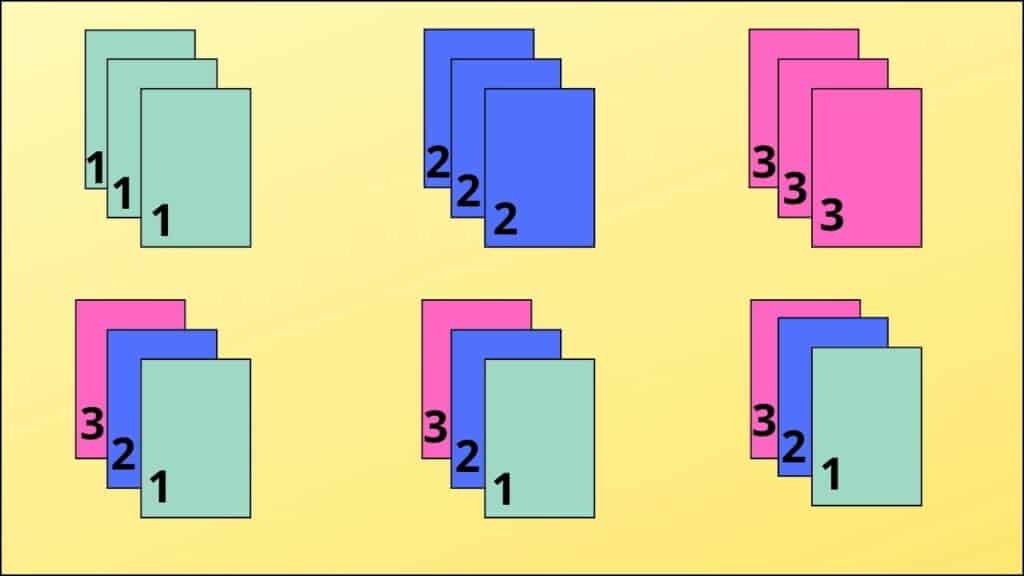What does collate in printing mean? It’s a term that might sound a bit technical, but it’s actually a simple concept with a huge impact on the final printed product. In essence, collation refers to the process of arranging the pages of a document in the correct order before they are bound or assembled.
Imagine a multi-page document, like a book or a magazine. Collation ensures that the pages are sequenced correctly so that the reader can follow the story or information seamlessly.
Think about a stack of pages that need to be assembled into a final product. Collation involves taking those individual pages and arranging them in the right sequence, ensuring that the pages flow logically from start to finish. This process is crucial for producing high-quality printed materials, as it guarantees that the content is presented in the intended order.
Definition of Collation in Printing

Collation is a crucial step in the printing process, especially when dealing with multiple pages or documents. It involves arranging pages in the correct order before they are bound or assembled into a finished product.
What is Collation in Printing?
Collation in printing refers to the process of arranging printed sheets or pages in the correct sequence to form a complete document. It ensures that the pages are in the right order, preventing any misplacement or errors in the final product.
Real-World Scenario
Imagine you’re printing a 20-page booklet. Each page is printed on a separate sheet of paper. Before binding, you need to collate the pages in the correct order, starting with page 1 and ending with page 20. This ensures that when the booklet is bound, the pages are in the right sequence, and the reader can follow the content without any confusion.
Purpose of Collation in Printing

Collation in printing plays a crucial role in ensuring the accuracy and order of printed documents, particularly when dealing with multi-page documents. Its primary purpose is to arrange the pages of a document in the correct sequence before binding or finishing.
This seemingly simple process is vital for creating professional-looking and error-free printed materials.
Importance of Collation
Collation is essential for ensuring that printed documents are assembled correctly, guaranteeing a smooth reading experience for the recipient. When pages are collated properly, readers can follow the intended flow of information without encountering any disruptions or inconsistencies.
Consequences of Incorrect Collation
Incorrect collation can have several detrimental consequences, impacting both the aesthetics and functionality of printed documents.
- Disrupted Reading Experience:Misplaced pages can lead to a confusing and frustrating reading experience for the recipient, hindering comprehension and potentially creating a negative impression.
- Errors and Misinformation:Incorrectly collated documents can present information out of order, leading to errors and potential misinformation. This can be particularly problematic for documents containing critical data, instructions, or legal information.
- Professional Image:Inaccurate collation can damage the professional image of the organization or individual responsible for the printing. It reflects a lack of attention to detail and can undermine the credibility of the document.
- Increased Costs:Re-printing and re-collating incorrectly assembled documents can lead to significant cost overruns, particularly for large print runs. This waste of resources and time can be avoided with proper collation practices.
Collation Methods

Collating printed documents refers to arranging pages in the correct order before binding or finishing. This ensures that the final product is assembled correctly and that pages are not missing or out of sequence. There are various methods used for collating, ranging from manual processes to automated systems.
Manual Collation
Manual collation is a traditional method where pages are arranged by hand. This method is suitable for small print runs or projects where accuracy is paramount.
Steps Involved in Manual Collation
- Prepare the printed sheets:Ensure that all the printed sheets are stacked neatly and in the correct order.
- Identify the page numbers:Check the page numbers on each sheet and verify that they are in sequential order.
- Start collating:Begin by taking the first sheet from each stack and placing them together in the correct order. Repeat this process for each subsequent sheet until all the pages are collated.
- Verify the collation:Once the pages are collated, carefully check the sequence of the pages to ensure that they are in the correct order.
Automated Collation
Automated collation uses specialized machines to arrange pages efficiently and accurately. This method is ideal for large print runs and projects where speed and precision are crucial.
Automated Collation Process Flowchart
Printed sheets are fed into the machine.
The machine scans the page numbers and identifies the correct order.
Pages are automatically collated and stacked in the correct sequence.
The collated pages are outputted from the machine, ready for binding or finishing.
Collation Terminology
Collation in printing involves arranging printed sheets in the correct order before binding. Understanding the terminology used in collation is essential for anyone involved in the printing process. This section will explain some of the most common terms used in collation.
Common Terms Used in Collation
| Term | Definition |
|---|---|
| Signature | A signature is a group of pages printed on a single sheet of paper that are folded to form a section of the final book. Signatures are typically identified by a letter or number, such as “A1” or “B2.” For example, a signature might consist of 8 pages printed on a single sheet, which is then folded into a 4-page section. |
| Section | A section is a group of pages that are bound together to form a part of the final book. Sections are typically made up of multiple signatures. For example, a book might be divided into three sections: a preface, the main body of the text, and an appendix. |
| Gather | To gather is the process of collecting the signatures in the correct order to form the complete book. This involves placing the signatures in a stack, ensuring that each signature is in its correct position. For example, a book with 16 pages might have 4 signatures (A, B, C, D), which are gathered in the correct order before being bound. |
Applications of Collation
Collation is a fundamental process in printing that ensures the correct order of pages within a printed document. This process is essential for creating high-quality printed materials, particularly for publications like books, magazines, and brochures.
Collation in Book Printing
Collation plays a crucial role in book printing, ensuring the accurate sequencing of pages within a book. This process is vital for creating a cohesive and readable book.
- During book printing, individual sheets of paper containing multiple pages are printed. These sheets are then collated in the correct order, ensuring that the pages flow seamlessly from one sheet to the next.
- Collation is essential for maintaining the integrity of the book’s narrative, allowing readers to follow the story or information in the intended sequence.
- Collation also ensures that the book’s layout is consistent, with pages aligned correctly and sections appearing in the intended order.
Collation in Magazine Printing
Similar to book printing, collation is critical in magazine printing to maintain the order of pages and sections.
- Magazines often have multiple sections, such as features, articles, and advertisements, which need to be collated in the correct sequence.
- Collation ensures that the magazine’s content is presented in a logical and engaging manner, allowing readers to easily navigate through different sections and topics.
- This process also helps in maintaining the magazine’s visual appeal by ensuring that pages are aligned and sections appear in the intended order.
Collation in Brochure Printing
Collation is also essential in brochure printing, particularly for multi-page brochures that require specific page ordering.
In printing, collating means arranging pages in the correct order, like assembling a deck of cards. So, when you’re printing a multi-page document, you might want to know what does collate on printer mean to ensure your pages are in the right sequence.
Collating is basically organizing printed sheets so they form a complete document, making it easier to read and bind.
- Brochures often have a clear flow of information, with sections that build upon each other. Collation ensures that these sections are presented in the correct order, allowing readers to understand the information presented.
- This process also ensures that the brochure’s design and layout are maintained, with pages aligned and sections appearing in the intended order.
- Collation in brochure printing is particularly important for marketing materials, as it ensures that the information is presented in a clear and concise manner, enhancing the effectiveness of the marketing message.
Benefits of Collation
Collation in printing is not just a technical process; it’s a crucial step that significantly impacts the final product’s quality, efficiency, and overall cost-effectiveness. By arranging pages in the correct order, collation ensures that printed materials are assembled accurately and consistently, delivering a polished and professional outcome.
Efficiency Gains
Collation streamlines the printing process by automating the arrangement of pages, eliminating the need for manual sorting and assembly. This automation significantly reduces the time and effort required to produce printed materials, especially for large print runs. For example, a printer handling a 100-page document with a print run of 1,000 copies would save considerable time and effort by using a collating machine compared to manual sorting.
Accuracy and Consistency
The primary benefit of collation is its ability to ensure accuracy and consistency in the final printed output. By precisely aligning pages in the correct order, collation eliminates the risk of errors such as missing pages, misplaced sections, or incorrect page sequences.
This is particularly important for documents with complex layouts, multiple sections, or large page counts. For instance, a legal document with numerous exhibits and appendices would require meticulous collation to avoid any errors that could have serious legal implications.
Cost Savings, What does collate in printing mean
Proper collation contributes to cost savings in several ways. Firstly, by automating the page arrangement process, collation reduces labor costs associated with manual sorting and assembly. Secondly, by minimizing errors, collation reduces the need for reprints, which can be costly, especially for large print runs.
Lastly, efficient collation can lead to faster turnaround times, allowing printers to handle more jobs and generate higher revenue.
Challenges of Collation

Collation, while essential for ensuring accurate and organized printed materials, can present a number of challenges. These challenges can lead to errors that affect the final product, potentially leading to costly reprints or customer dissatisfaction.
Potential Sources of Errors
Understanding the potential sources of errors during the collation process is crucial for implementing effective prevention strategies. The following factors can contribute to errors:
- Human Error:Collation often involves manual tasks, making human error a significant factor. This can include miscounting pages, placing pages in the wrong order, or overlooking damaged pages.
- Machine Malfunction:Collation machines, like any mechanical equipment, can malfunction. This can result in misaligned pages, skipped pages, or inaccurate stacking. Regular maintenance and calibration are essential to minimize these risks.
- Complex Layouts:Collation becomes more challenging when dealing with complex document layouts, such as those with multiple inserts, foldouts, or different page sizes. This requires careful planning and precise execution.
- High Volume:High-volume printing projects can increase the likelihood of errors due to fatigue, time constraints, and increased pressure on personnel and machinery.
Strategies for Addressing Challenges
Addressing the challenges of collation requires a multi-faceted approach, focusing on both human and technological aspects. Here are some strategies:
- Quality Control:Implementing rigorous quality control measures is essential. This includes regular checks throughout the collation process, visual inspections of the final product, and using automated systems for verification.
- Training and Standardization:Training operators on proper collation techniques and standardizing procedures can reduce human error. This includes clear instructions, checklists, and regular training sessions.
- Technology Solutions:Utilizing technology can enhance efficiency and accuracy. This includes using automated collation machines, barcode scanning systems, and software for document management and tracking.
- Process Optimization:Streamlining the collation process can minimize potential errors. This involves optimizing workflows, minimizing manual tasks, and implementing error-proofing measures.
Essential FAQs: What Does Collate In Printing Mean
What are the different methods of collation?
There are two main methods: manual collation, where pages are arranged by hand, and automated collation, where machines handle the process.
What happens if a document is collated incorrectly?
Incorrect collation can lead to a confusing and frustrating reading experience, as pages might be out of order. It can also create issues with binding and assembly.
How does collation affect the cost of printing?
Proper collation can actually reduce costs by minimizing errors and rework. Incorrect collation can lead to delays and wasted materials.
